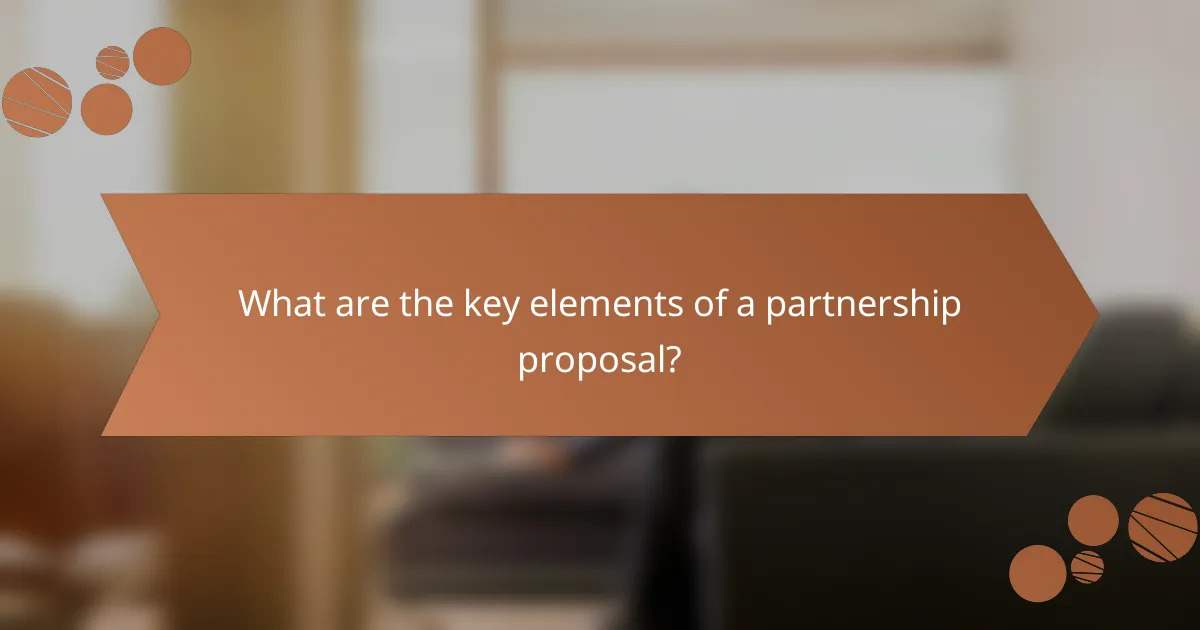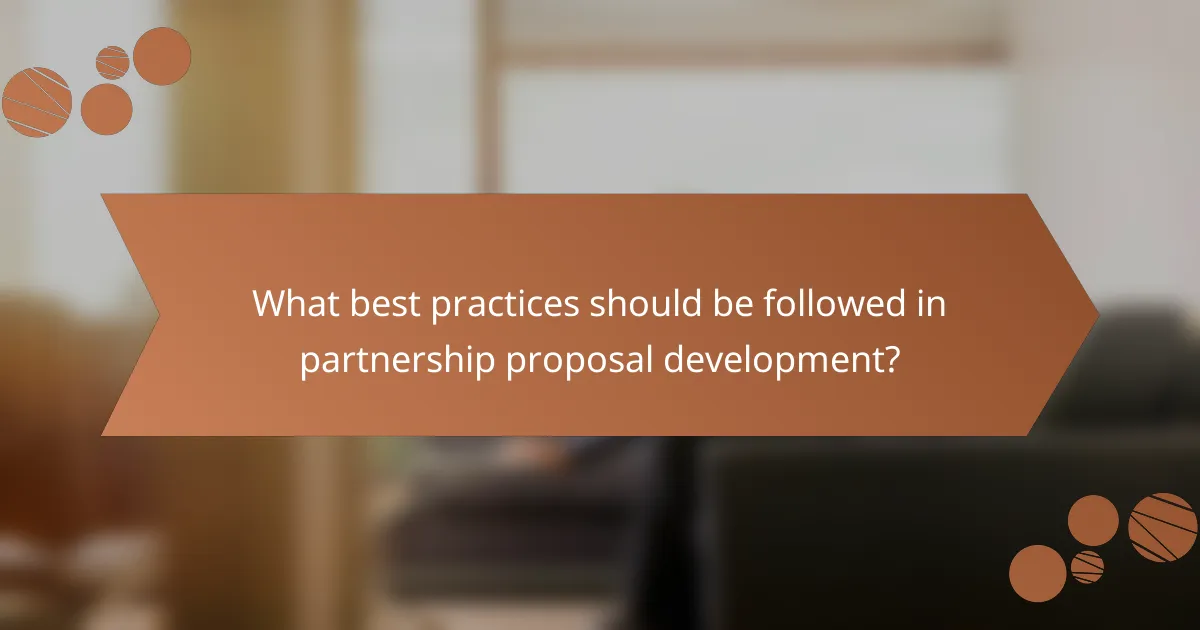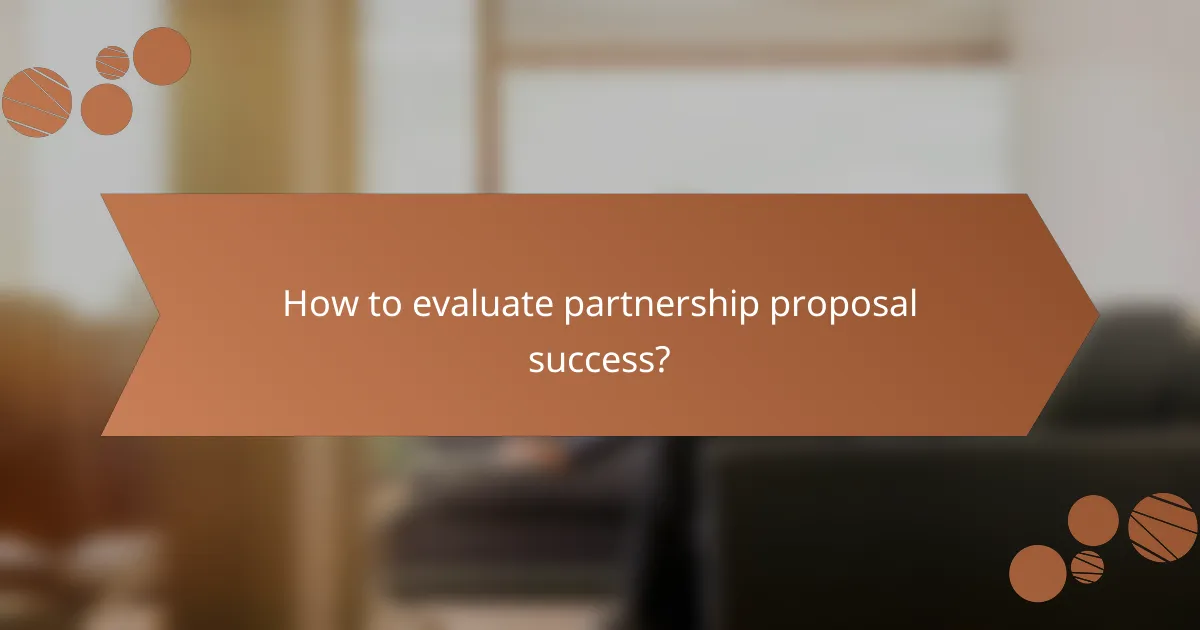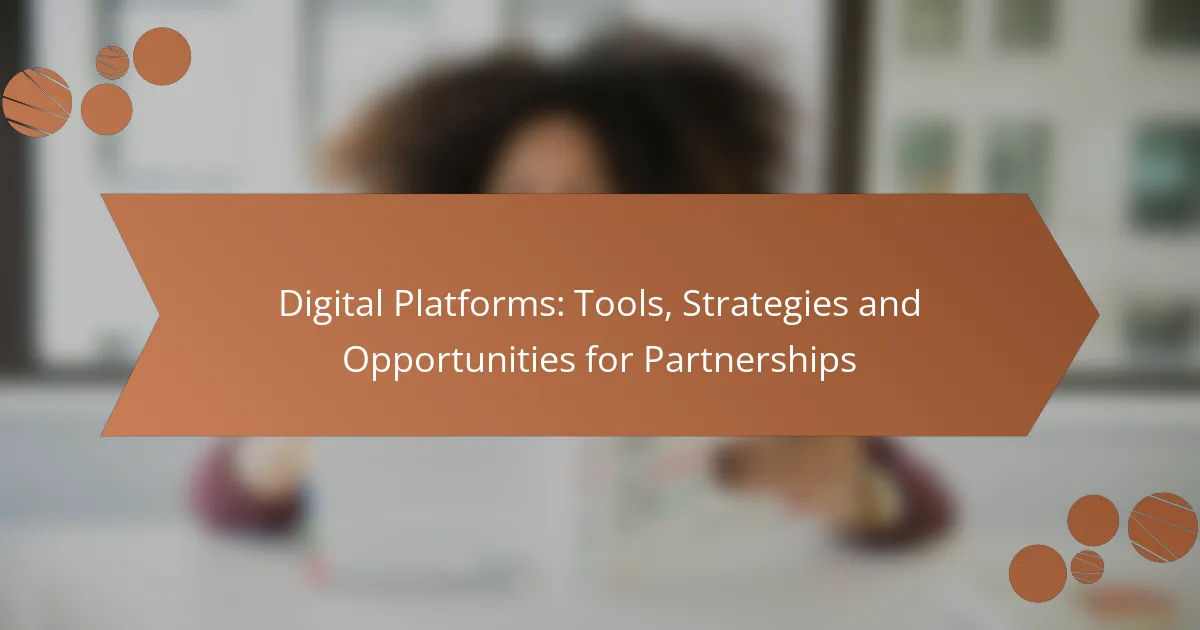Developing a partnership proposal is a critical step in establishing successful collaborations, requiring a clear outline of essential components such as objectives, roles, and financial considerations. A well-structured proposal serves as a roadmap, ensuring all stakeholders understand their responsibilities and the expected outcomes. By emphasizing thorough research and effective communication, you can enhance the likelihood of securing a fruitful partnership.

What are the key elements of a partnership proposal?
A partnership proposal should clearly outline the essential components that define the collaboration. Key elements include an executive summary, objectives, roles, financial considerations, and a timeline, all of which help stakeholders understand the partnership’s purpose and structure.
Executive summary
The executive summary provides a concise overview of the partnership proposal, highlighting its main points. It should capture the essence of the collaboration, including the parties involved, the purpose of the partnership, and the anticipated benefits.
Keep this section brief, ideally one page or less, to engage readers quickly. Use straightforward language to ensure clarity and avoid jargon that may confuse stakeholders.
Objectives and goals
Clearly defined objectives and goals are crucial for guiding the partnership’s direction. These should be specific, measurable, achievable, relevant, and time-bound (SMART), ensuring all parties understand what success looks like.
For example, if the partnership aims to increase market share, specify the target percentage and the timeframe for achieving it. This clarity helps in aligning efforts and measuring progress.
Roles and responsibilities
Defining roles and responsibilities is essential to avoid confusion and ensure accountability. Each partner should know their specific duties, which can be outlined in a table for clarity.
| Partner | Role | Responsibilities |
|---|---|---|
| Partner A | Lead Coordinator | Manage project timelines and communication |
| Partner B | Financial Officer | Oversee budget and financial reporting |
Financial considerations
Financial considerations should detail the budget, funding sources, and expected expenses and revenues. Clearly outline how costs will be shared among partners and any financial commitments required from each party.
Consider including a budget breakdown to provide transparency. This helps partners understand their financial obligations and the overall financial health of the partnership.
Timeline and milestones
A well-structured timeline with milestones is vital for tracking progress and ensuring accountability. Outline key phases of the partnership, including start and end dates, and significant milestones that indicate progress.
For instance, you might set quarterly reviews to assess achievements against goals. This structured approach helps maintain momentum and allows for timely adjustments if needed.

How to structure a partnership proposal?
A well-structured partnership proposal clearly outlines the objectives, benefits, and responsibilities of each party involved. It serves as a roadmap for collaboration, ensuring that all stakeholders understand their roles and the expected outcomes.
Introduction section
The introduction section sets the stage for the proposal by summarizing the purpose and significance of the partnership. It should engage the reader and provide a brief overview of the mutual benefits anticipated from the collaboration.
Include a compelling statement about the potential impact of the partnership, highlighting any relevant experience or successes that lend credibility to your proposal.
Partnership overview
This section provides a detailed description of the partnership, including the goals, scope, and vision. Clearly define what each party brings to the table and how these contributions align with the partnership objectives.
Consider including a brief history of both organizations and any previous collaborations that demonstrate a successful track record. This context can strengthen the proposal’s appeal.
Detailed proposal sections
In the detailed proposal sections, break down the specific components of the partnership. This may include roles and responsibilities, timelines, resource allocation, and financial considerations.
- Roles and Responsibilities: Clearly delineate what each partner is expected to do.
- Timelines: Provide a timeline for key milestones and deliverables.
- Financial Considerations: Outline any funding, revenue sharing, or cost-sharing arrangements.
Using tables can help present complex information clearly, making it easier for stakeholders to digest the details.
Conclusion and call to action
The conclusion should summarize the key points of the proposal and reiterate the benefits of the partnership. This is your opportunity to reinforce the value of collaboration and the positive outcomes expected.
End with a strong call to action, encouraging the recipient to respond or schedule a meeting to discuss the proposal further. Make it clear how they can take the next steps to move forward with the partnership.

What best practices should be followed in partnership proposal development?
Effective partnership proposal development requires a strategic approach that emphasizes thorough research, clear communication, audience tailoring, and appropriate visual aids. Following these best practices can significantly enhance the chances of securing a successful partnership.
Research and analysis
Conducting comprehensive research and analysis is crucial for understanding potential partners and their needs. This involves gathering data on their business goals, market position, and previous partnerships to identify alignment opportunities.
Utilize tools like SWOT analysis to assess strengths, weaknesses, opportunities, and threats related to the partnership. This structured approach helps in crafting a proposal that addresses specific interests and concerns of the potential partner.
Clear communication
Clear communication is essential in partnership proposals to convey intentions and expectations effectively. Use straightforward language and avoid jargon that may confuse the reader.
Ensure that the proposal outlines the benefits of the partnership for both parties, emphasizing mutual gain. Regular follow-ups and open channels for questions can also facilitate better understanding and engagement.
Tailoring to audience
Tailoring your proposal to the specific audience increases its relevance and impact. Research the potential partner’s culture, values, and decision-making processes to align your proposal accordingly.
For instance, if the partner values sustainability, highlight how the partnership can contribute to environmental goals. Customizing your approach demonstrates respect for their priorities and enhances the proposal’s appeal.
Visual aids and formatting
Incorporating visual aids and proper formatting can significantly enhance the readability and professionalism of a partnership proposal. Use charts, graphs, and infographics to present data clearly and concisely.
Maintain a clean layout with headings, bullet points, and white space to guide the reader through the document. This not only makes the proposal more engaging but also helps to emphasize key points effectively.

What are common mistakes to avoid in partnership proposals?
Common mistakes in partnership proposals include unclear objectives, insufficient data backing, and neglecting the needs of the target audience. Avoiding these pitfalls can significantly enhance the effectiveness of your proposal and increase the likelihood of successful partnerships.
Vagueness in objectives
Vague objectives can lead to misunderstandings and misaligned expectations between partners. Clearly defined goals should be specific, measurable, achievable, relevant, and time-bound (SMART). For example, instead of stating “increase sales,” specify “increase sales by 20% within the next year.” This clarity helps all parties understand their roles and contributions.
To avoid vagueness, outline the objectives in detail and ensure they align with both partners’ strategic goals. Regularly revisit these objectives to ensure they remain relevant throughout the partnership.
Lack of data support
Proposals lacking data support can appear unconvincing and may lead to skepticism from potential partners. It’s crucial to include relevant data that demonstrates market trends, potential growth, and the benefits of the partnership. For instance, citing industry reports or case studies can provide a solid foundation for your claims.
Utilize graphs or tables to present data clearly and concisely. Ensure that the data is up-to-date and sourced from reputable organizations to enhance credibility.
Ignoring audience needs
Ignoring the needs of the audience can result in proposals that fail to resonate. Understanding the priorities and pain points of potential partners is essential for crafting a compelling proposal. Conducting research or surveys can help identify these needs.
Tailor your proposal to address specific concerns and highlight how the partnership will benefit both parties. This approach not only demonstrates empathy but also increases the chances of a favorable response.

How to evaluate partnership proposal success?
Evaluating the success of a partnership proposal involves assessing its alignment with strategic goals and measuring outcomes against predefined objectives. Key metrics may include financial performance, stakeholder satisfaction, and overall impact on business growth.
Key performance indicators (KPIs)
Key performance indicators (KPIs) are essential for measuring the success of a partnership proposal. Common KPIs include revenue growth, market share increase, and customer acquisition rates. Establishing specific, measurable, achievable, relevant, and time-bound (SMART) criteria for these indicators can provide clear benchmarks for evaluation.
For example, if a partnership aims to increase sales by 20% within a year, tracking monthly sales figures against this target will help assess progress. Regularly reviewing these KPIs allows for timely adjustments to strategies if necessary.
Stakeholder feedback
Gathering feedback from stakeholders is crucial for evaluating the success of a partnership proposal. This can include surveys, interviews, or focus groups with employees, customers, and partners. Their insights can reveal how well the partnership is perceived and its effectiveness in meeting their needs.
For instance, if customer feedback indicates dissatisfaction with a new product resulting from the partnership, it may signal a need for changes in collaboration or product development. Engaging stakeholders throughout the process fosters transparency and trust.
Financial analysis
Conducting a financial analysis is vital to assess the economic impact of a partnership proposal. This involves reviewing costs, revenues, and profitability associated with the partnership. A thorough cost-benefit analysis can help determine whether the partnership is financially viable and aligns with overall business objectives.
For example, if the partnership incurs high operational costs but yields minimal revenue growth, it may not be sustainable. Regular financial reviews can help identify trends and inform future decisions regarding the partnership.
Long-term impact assessment
Evaluating the long-term impact of a partnership proposal is essential for understanding its sustainability and contribution to strategic goals. This assessment should consider not only immediate outcomes but also potential future benefits, such as brand enhancement and market positioning.
For instance, a partnership that initially appears unprofitable may lead to significant market share growth over time. Establishing a timeline for reviewing long-term impacts can help ensure that the partnership remains aligned with evolving business objectives.



